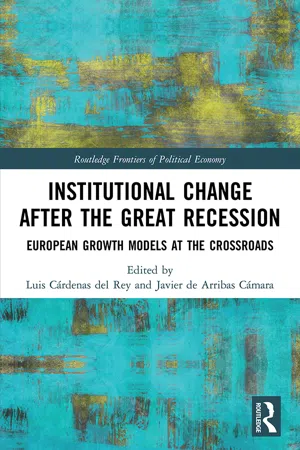
Institutional Change after the Great Recession
European Growth Models at the Crossroads
- 328 pages
- English
- ePUB (mobile friendly)
- Available on iOS & Android
Institutional Change after the Great Recession
European Growth Models at the Crossroads
About this book
This book combines demand-led growth models and the institutionalist approach, in order to explain the macroeconomic performance of the main European countries in recent years followed by which a coherent explanation of the institutional change since the Great Recession, including the economic policy response to the economic and financial crisis (2008) and to the debt crisis (2010) is provided.
A "Comparative Political Economy" (CPE) analytical framework and provide an institutional base to the different European growth models is built, in general terms over the period 1995-2018. The results allow us to link diverse growth dynamics to the changes of the institutional framework as a consequence of the economic and financial crises. In each chapter for country case studies (France, Germany, Italy, Spain, Greece, Sweden, UK and Poland) there;'s an ntroduction with a general characterization of the country and the most relevant changes that have occurred subsequently (main legislative milestones or changes in the behaviour of social agents) especially the process of dualization or deregulation of European economies. In addition, an analysis of the macroeconomic evolution and the situation of the labour market before and after the crisis from a demand-side perspective is included, concluding with the linkages between both issues and the characterization of the growth model.
This book is of special interest to all the students and university professors who will use this book to be able to follow a multitude of subjects from Applied Economy to International Economic Structure but can also be useful for researchers, doctoral students and teaching staff who want to expand knowledge in the fields of comparative political economy, institutions and the European Union. In general, this book is aimed at anyone interested in expanding their knowledge of the evolution of Europe today.
Frequently asked questions
- Essential is ideal for learners and professionals who enjoy exploring a wide range of subjects. Access the Essential Library with 800,000+ trusted titles and best-sellers across business, personal growth, and the humanities. Includes unlimited reading time and Standard Read Aloud voice.
- Complete: Perfect for advanced learners and researchers needing full, unrestricted access. Unlock 1.4M+ books across hundreds of subjects, including academic and specialized titles. The Complete Plan also includes advanced features like Premium Read Aloud and Research Assistant.
Please note we cannot support devices running on iOS 13 and Android 7 or earlier. Learn more about using the app.
Information
1 Introduction
Javier Arribas and Luis Cárdenas
1 Introduction
Table of contents
- Cover
- Half Title
- Series Page
- Title Page
- Copyright Page
- Dedication
- Table of Contents
- List of figures
- List of tables
- List of contributors
- Acknowledgments
- Abbreviations
- 1. Introduction
- 2. Foundations of a growth model perspective
- 3. Institutional reform and changes in the economic governance of the European Union after the economic crisis
- 4. France: Low inequality despite poor economic performance in a debt-financed consumption-led model
- 5. The mechanics of German capitalism: Dualism and inequality in an export-led economy
- 6. The impact of the institutional change on the economic growth path in Greece
- 7. Italy and the global financial crisis: The fallacy of debt-led growth through moderation, austerity, and populism
- 8. In the eye of the storm: The “success” of the Spanish growth model
- 9. This time was different: The crisis that went past Sweden
- 10. Financial services industry power and labor market polarization in the UK debt-led growth model
- 11. Financial and economic crisis within the EU: Consequences for the Polish banking institutional system
- 12. Conclusion
- Index